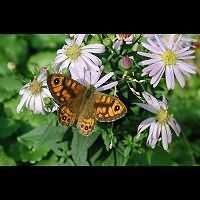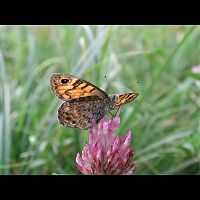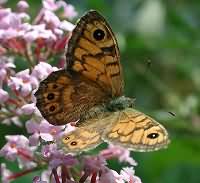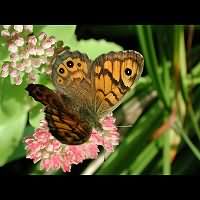The Wall Lasiommata megera
A very common Brown is the Wall. Yet we do not see many of them in our garden, probably because it is situated near woods and so attracting Speckled Woods instead of Walls. Separating the males from the females is easy: the males have a broad line of distinctive black scales, which the females lack. These scales produce a scent to which the females are attracted. Most seen are the females. This is due to the males occupying a territory from which other males are chased away, while females may pass freely. Besides the males are extremely unquiet and fly away quickly when disturbed. Photograping the males is a real challenge, while many females are grateful models. In the top picture is a male and in the one below a female.
The Wall is quite common in most of Europe, the Middle East and Central Asia. It is absent though in Northern Scotland, most of Scandinavia and in Ireland. Specimens from southern parts of Europe and from the Middle East are more greyish and less beautiful than specimens from the moderate zones of Europe and Asia. The animal has no particular demands for its presence, except for the grass needed for the caterpillars. It is quite variable in matters of size. Some don't even reach 30 mm, while others reach a wingspan of 46 mm.
The caterpillar of the Wall is bright yellowish green with white stripes. It eats various grasses, like all other caterpillars of browns do. Three broods are produced yearly. The animal is therefore flying about for a long time: from April to November. However the highest numbers of individuals are reached by the end of May and the beginning of June and in August. The caterpillars overwinter. The pupa is attached to grass stems. The Wall is a beautiful brown indeed, sometimes looking like the Small Tortoiseshell because of the colour. The eyes on the backside of the wings give it away immediately though.
A very common Brown is the Wall. Yet we do not see many of them in our garden, probably because it is situated near woods and so attracting Speckled Woods instead of Walls. Separating the males from the females is easy: the males have a broad line of distinctive black scales, which the females lack. These scales produce a scent to which the females are attracted. Most seen are the females. This is due to the males occupying a territory from which other males are chased away, while females may pass freely. Besides the males are extremely unquiet and fly away quickly when disturbed. Photograping the males is a real challenge, while many females are grateful models. In the top picture is a male and in the one below a female.
The Wall is quite common in most of Europe, the Middle East and Central Asia. It is absent though in Northern Scotland, most of Scandinavia and in Ireland. Specimens from southern parts of Europe and from the Middle East are more greyish and less beautiful than specimens from the moderate zones of Europe and Asia. The animal has no particular demands for its presence, except for the grass needed for the caterpillars. It is quite variable in matters of size. Some don't even reach 30 mm, while others reach a wingspan of 46 mm.
The caterpillar of the Wall is bright yellowish green with white stripes. It eats various grasses, like all other caterpillars of browns do. Three broods are produced yearly. The animal is therefore flying about for a long time: from April to November. However the highest numbers of individuals are reached by the end of May and the beginning of June and in August. The caterpillars overwinter. The pupa is attached to grass stems. The Wall is a beautiful brown indeed, sometimes looking like the Small Tortoiseshell because of the colour. The eyes on the backside of the wings give it away immediately though.









